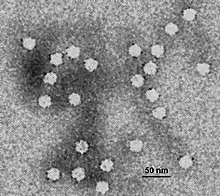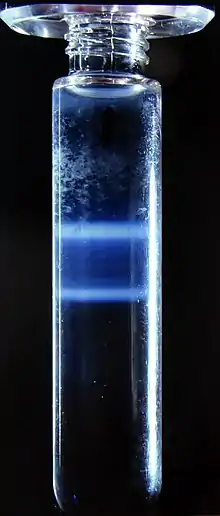
Buoyant density centrifugation (also isopycnic centrifugation or equilibrium density-gradient centrifugation) uses the concept of buoyancy to separate molecules in solution by their differences in density.
Implementation
Historically a cesium chloride (CsCl) solution was often used, but more commonly used density gradients are sucrose or Percoll. The sample is put on top of the solution, and then the tube is spun at a very high speed for an extended time, at times lasting days. The CsCl molecules become densely packed toward the bottom, so a continuous gradient of layers of different densities (and CsCl concentrations) form. Since the original solution was approximately the same density, they go to a level where their density and the CsCl density are the same, to which they form a sharp, distinctive band.

Isotope separation
This method very sharply separates molecules, and is so sharp that it can even separate different molecular isotopes from one another.[1]
DNA separation
Buoyant density of the majority of DNA is 1.7g/cm3[2] which is equal to the density of 6M CsCl solution. Buoyant density of DNA changes with its GC content. The term "satellite DNA" refers to small bands of repetitive DNA sequences with distinct base composition floating above (A+T rich) or below (G+C rich) the main component DNA.
See also
References
- ↑ Dumont, Marc G.; Murrell, J. Colin (June 2005). "Stable isotope probing — linking microbial identity to function". Nature Reviews Microbiology. 3 (6): 499–504. doi:10.1038/nrmicro1162. ISSN 1740-1534. PMID 15886694. S2CID 24051877.
- ↑ Arrighi, Frances E.; Mandel, Manley; Bergendahl, Janet; Hsu, T. C. (June 1970). "Buoyant densities of DNA of mammals". Biochemical Genetics. 4 (3): 367–376. doi:10.1007/BF00485753.
Further reading
- Schildkraut, Carl L.; Marmur, Julius; Doty, Paul (1962). "Determination of the base composition of deoxyribonucleic acid from its buoyant density in CsCl". Journal of Molecular Biology. 4 (6): 430–443. doi:10.1016/S0022-2836(62)80100-4. ISSN 0022-2836. PMID 14498379.
- James Greene (25 June 1998). Recombinant DNA Principles and Methodologies. CRC Press. pp. 278–. ISBN 978-0-8247-9989-2.